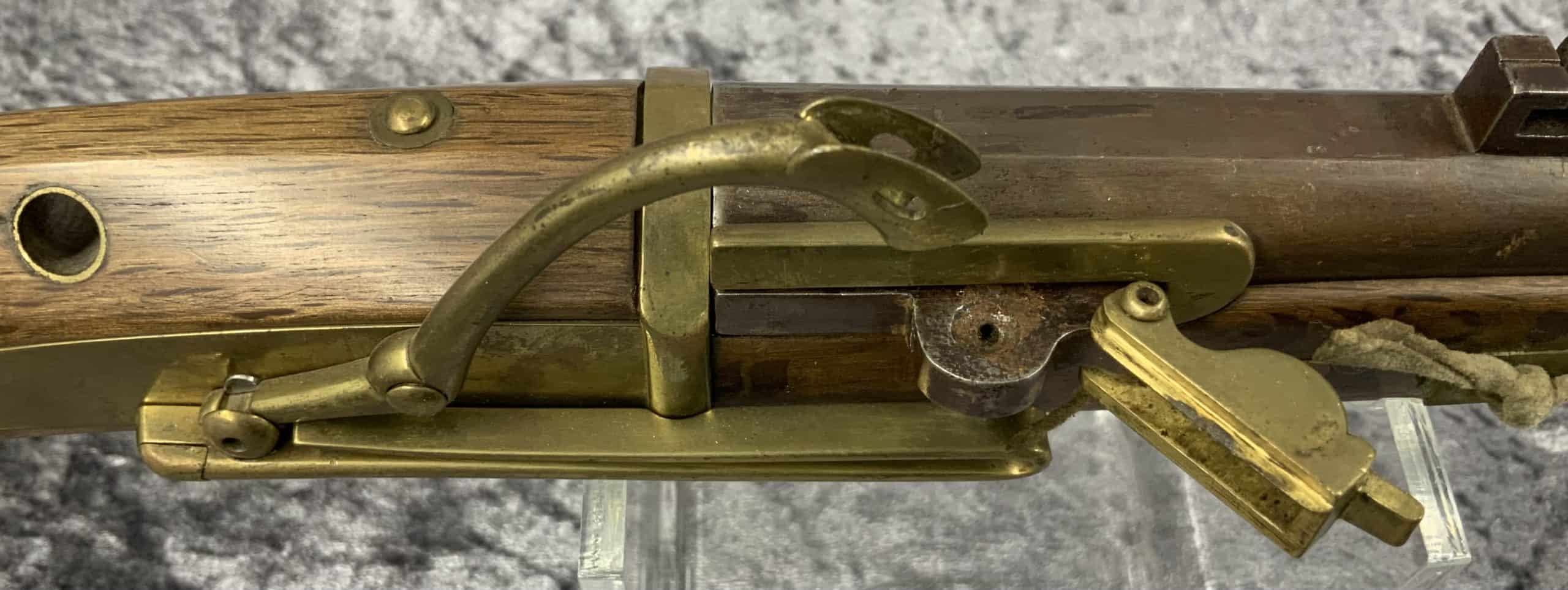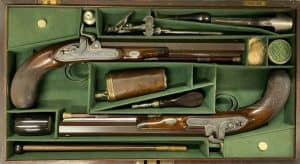Description
Japanese Matchlock Pistol
Japanese Matchlock Pistol. A FINE JAPANESE LONG SNAP-MATCHLOCK PISTOL, CIRCA 1880 with rebrowned swamped barrel formed with a full length flat, pronounced brass fore-sight, steel back-sight, integral pan with brass cover, and signed beneath the breech, brass action of characteristic form including moulded serpentine engaged by a steel sear, and brass external mainspring, figured cherry wood full stock pierced with brass-lined apertures to secure the barrel, long brass belt hook, and cherry wood ramrod. The signature is that of Enamiya Jimbei who worked in Seshu province.
A pistol made with excellence and without a doubt would have been expensive.
Overall Length: 48cm
Barrel Length: 27cm
Calibre: Approx 34 Bore
Weight: 1.29kg
The bajō-zutsu (馬上筒) was a tanegashima in the form of a pistol. Bajō-zutsu were used by mounted samurai in feudal Japan. These small calibre guns were primarily used for shooting on horseback. With a relatively longer barrel than the regular pistol size they were called “bajouzutsu”. They have the same sophisticated design and are made with similar balance. These short barrelled guns were advantageous when battles occurred at short range and were noted to be widely used by Samurai of high rank.
The tanegashima seems to have been based on snap matchlocks that were produced in Portuguese Malacca, at the armoury of Malacca, a colony of Portugal since 1511, called an istinggar in Malay. The name tanegashima came from the Japanese island (Tanegashima) where a Chinese junk with Portuguese adventurers on board was driven to anchor by a storm in 1543. The lord of the Japanese island, Tanegashima Tokitaka (1528–1579), purchased two matchlock muskets from the Portuguese and put a swordsmith to work copying the matchlock barrel and firing mechanism. The smith, Yaita, did not have much of a problem with most of the gun but “drilling the barrel helically so that the screw (bisen bolt) could be tightly inserted” was a major problem as this “technique did not apparently exist in Japan until this time.”
The Portuguese fixed their ship and left the island and only in the next year when a Portuguese blacksmith was brought back to Japan was the problem solved. Within ten years of its introduction, over 300,000 tanegashima firearms were reported to have been manufactured.
The arrival in Japan of the United States Navy led by Matthew C. Perry in 1854 started a period of rearmament. The tanegashima was an antiquated weapon by the 1800s and various samurai factions acquired advanced firearms including the minié rifle, breech-loading and repeating rifles. The samurai era ended in 1868 with the Meiji; Japan turned to a national conscription army with modern weapons and uniforms. Some gunsmiths did replace their matchlock-type tanegashimas into percussion cap mechanisms while retaining its design as a musket. The last use of samurai armour and traditional weapons in Japan, including tanegashima, was during the Satsuma Rebellion (1877), when the Meiji government’s newly established Imperial Japanese Army put an end to the last samurai and their resistance to modernization.
Click here for more Japanese items







